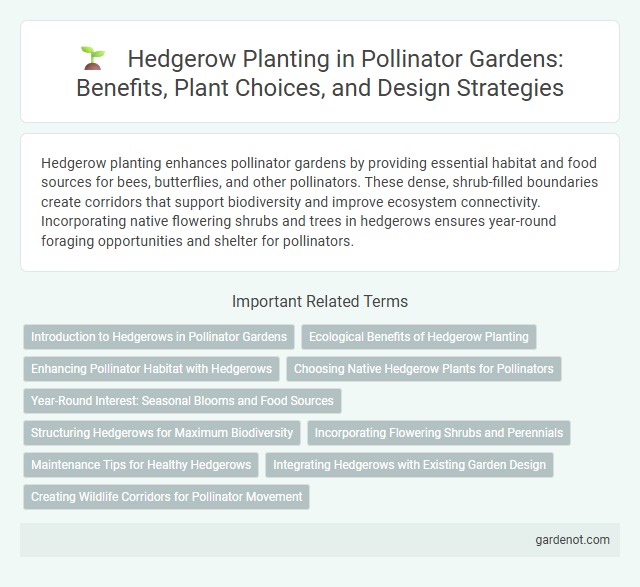Hedgerow planting enhances pollinator gardens by providing essential habitat and food sources for bees, butterflies, and other pollinators. These dense, shrub-filled boundaries create corridors that support biodiversity and improve ecosystem connectivity. Incorporating native flowering shrubs and trees in hedgerows ensures year-round foraging opportunities and shelter for pollinators.
Introduction to Hedgerows in Pollinator Gardens
Hedgerow planting introduces a diverse array of flowering shrubs and native plants that provide essential nectar and pollen resources for pollinators throughout the seasons. These linear habitats act as corridors supporting bees, butterflies, and other beneficial insects by offering shelter, nesting sites, and continuous foraging opportunities. Integrating hedgerows in pollinator gardens enhances biodiversity, improves ecosystem resilience, and promotes sustainable pollination services.
Ecological Benefits of Hedgerow Planting
Hedgerow planting enhances biodiversity by providing essential habitats and corridors for pollinators such as bees, butterflies, and other beneficial insects. These vegetative strips improve soil health, reduce erosion, and support natural pest control through increased predator presence. By promoting ecological balance, hedgerows contribute to pollinator garden resilience and sustained ecosystem services.
Enhancing Pollinator Habitat with Hedgerows
Hedgerow planting significantly enhances pollinator habitat by providing continuous floral resources and shelter throughout the seasons, supporting diverse pollinator species such as bees, butterflies, and hoverflies. Native flowering shrubs and trees in hedgerows offer nectar, pollen, and nesting sites, boosting local biodiversity and ecological resilience. Strategic placement of hedgerows also creates corridors that facilitate pollinator movement across fragmented landscapes, improving pollination services in adjacent agricultural and natural areas.
Choosing Native Hedgerow Plants for Pollinators
Selecting native hedgerow plants such as blackthorn (Prunus spinosa), hawthorn (Crataegus monogyna), and elderberry (Sambucus nigra) provides essential nectar and pollen sources for bees, butterflies, and hoverflies. These species support diverse pollinator communities by offering sequential blooming periods from early spring to late autumn. Incorporating native shrubs enhances habitat connectivity and resilience in pollinator gardens.
Year-Round Interest: Seasonal Blooms and Food Sources
Hedgerow planting in pollinator gardens offers year-round interest by incorporating diverse native shrubs and flowering plants that bloom seasonally, ensuring continuous nectar and pollen availability. Early spring blossoms like hawthorn provide crucial food for emerging pollinators, while summer favorites such as butterfly bush support bees and butterflies. Late-season berries and seeds from plants like elderberry sustain pollinators through fall and winter, creating a balanced ecosystem that fosters biodiversity and supports pollinator populations throughout the year.
Structuring Hedgerows for Maximum Biodiversity
Structuring hedgerows for maximum biodiversity involves planting a diverse mix of native shrubs, trees, and flowering plants that provide continuous bloom throughout the seasons. Incorporating different plant heights and densities creates essential habitats for pollinators, birds, and beneficial insects. Hedgerows with layered vegetation enhance food sources and shelter, supporting thriving ecosystems in pollinator gardens.
Incorporating Flowering Shrubs and Perennials
Incorporating flowering shrubs and perennials into hedgerow planting significantly enhances pollinator gardens by providing diverse nectar and pollen sources throughout the growing season. Species such as lavender, butterfly bush, and native willow offer extended bloom periods and structural habitat, supporting bees, butterflies, and other beneficial insects. Strategic layering of these plants improves biodiversity, promotes natural pest control, and strengthens ecosystem resilience within the pollinator garden.
Maintenance Tips for Healthy Hedgerows
Regular pruning promotes dense growth and prevents disease in hedgerow plantings, enhancing their role as pollinator habitats. Applying mulch conserves soil moisture and suppresses weeds, supporting the diverse flora that attracts bees, butterflies, and other pollinators. Monitoring for pests and diseases ensures the longevity of native flowering shrubs and trees vital for sustaining pollinator populations.
Integrating Hedgerows with Existing Garden Design
Integrating hedgerows into an existing garden design enhances biodiversity by providing continuous habitat and food sources for pollinators such as bees, butterflies, and birds. Selecting native shrub species that bloom in succession supports a diverse pollinator community while complementing the garden's aesthetic and structural elements. Proper spacing and layering of hedgerow plants ensure optimal sunlight exposure and airflow, promoting healthy growth and maximizing pollinator activity.
Creating Wildlife Corridors for Pollinator Movement
Hedgerow planting establishes continuous wildlife corridors that facilitate pollinator movement across fragmented habitats, enhancing biodiversity and ecosystem resilience. Native flowering shrubs and trees in these corridors provide essential nectar sources, nesting sites, and shelter for bees, butterflies, and other pollinators. Strategic placement of hedgerows connects isolated pollinator populations, supporting genetic diversity and promoting effective pollination in adjacent agricultural and natural landscapes.
Hedgerow planting Infographic

 gardenot.com
gardenot.com